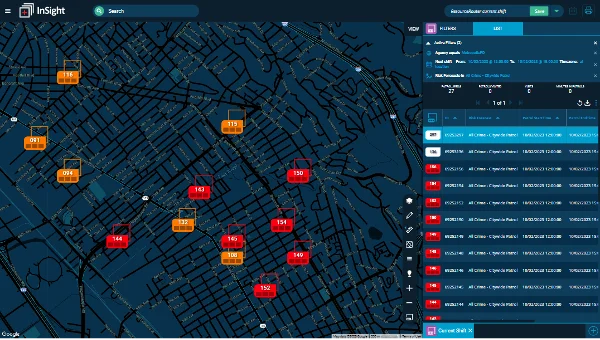To overcome these challenges, many law enforcement agencies are evolving to become more data-driven and proactive, while focusing on improving relations with the community and better allocating limited resources in the process.
In this article, we’ll cover some of the shortcomings of 20th-century policing strategies (and how they came to be), the rise of evidence-based policing in the 21st century, and how SoundThinking™ technology works in tandem with a proactive policing methodology to pave the way for better outcomes for police agencies and the communities they serve.
20th-Century Policing Strategies
It’s important to remember that in the 20th century, there was minimal ability to collect and analyze crime data. As Lawrence R. Sherman writes in his paper The Rise of Evidence-Based Policing: Targeting, Testing, and Tracking, in 1975 “There was almost no targeting of patterns or predictions of crime and disorder, no testing of what worked best to prevent or solve crimes and problems, or much tracking and managing of what police were doing, where, when, and how, in relation to any specific objectives. Most police agencies lacked computers.”
As such, police agencies used the limited resources and technology they had, like 9-1-1 systems, radios, and police cars, in a mostly reactive response. This type of strategy is commonly known as the ‘Three Rs.’ The Three Rs entailed:
- Randomized patrols
- Rapid response
- Reactive investigations
The Shortcomings of The Three Rs
This primarily reactive approach would often entail initiatives such as randomly patrolling large areas deemed a crime risk based primarily on gut instinct. However, over time it became clear that this approach was not reducing crime and, at times, caused a lot of strain amongst community members.
Many citizens felt overpoliced and subjected to bias. Additionally, this approach left gaps in police services, where community members living in underserved areas were not having their needs met. “What police did when they reacted to a citizen call was not subject to much police agency direction or analysis. The main organizational requirement was to arrive, do something and leave as quickly as possible,” Sherman writes. This reactive response is not nearly as effective as a proactive approach, where the police serve as advocates for underserved communities, connecting those citizens with the resources they need to feel safe.
According to Sherman, by 2012 the Three Rs model of policing was morphing into the more data-driven “Triple-T” strategy. The Three Ts are:
- Targeting
- Testing
- Tracking
What Is Evidence-Based Policing?
In mid-1998, Sherman outlined the need for research-based law enforcement in his paper, which was titled Evidence-Based Policing. He utilized the concept of “evidence-based medicine” to lay the foundation for his data-driven policing methodology.
The evidence-based policing approach took a while to catch on, but in his paper, The Rise of Evidence-Based Policing: Targeting, Testing, and Tracking, Sherman writes that by 2012, the Three Rs were starting to transform into a more data-driven Triple-T approach focused on targeting, testing, and tracking that proved more effective at reducing crime and improving community safety.
Sherman suggested that police action should be guided by scientific evidence so decision-makers can determine which tactics are most effective at combating crime. As he states in the abstract of his paper: “Evidence-based policing uses research to guide practices and evaluate practitioners. It uses the best evidence to shape the best practice.”
Paving the Way for Better Outcomes With Modern Technologies
SoundThinking offers a variety of precision policing solutions that help save lives, solve cases, and deter crime—all while making communities safer. Our technology suite embraces the evidence-based policing philosophy and ensures police departments have timely and accurate intelligence, can rapidly and precisely deploy resources to proactively prevent and respond to crime.
With ShotSpotter®, police know exactly when and where a gun was fired, prompting a rapid and precise response that consistently saves lives and helps keep communities safe.
With Resource Router™, command staff have patrol management software that uses artificial intelligence-driven analysis to create data-driven patrol plans that focus on touch points that maximize crime deterrence with minimal harm to the community.
Additionally, SoundThinking’s unique community-first approach has three protections in place to help establish impartiality when determining where proactive patrols are conducted. First, the system intelligently meters out where patrol assignments occur and limits their duration to reduce instances of over-policing. Second, the system ensures the algorithms that drive patrol recommendations use objective, non-crime data that mitigates potential bias. Third, the system does not use any personally identifiable information to determine where patrols should be assigned.
Ultimately, tools like ShotSpotter and ResourceRouter are enabling law enforcement agencies across the country to adapt to the proactive, evidence-based policing methods necessary for improving community relations and public safety in the world today.
Final Thoughts
With many law enforcement agencies understaffed and overworked, it’s more important than ever before that departments make efficient use of their limited resources. Ultimately, police agencies that embrace technology and adopt evidence-based policing are more effective at reducing crime while improving relationships with the communities that they serve.
ResourceRouter is a community-first patrol management solution that uses AI to direct officers to high-risk locations to prevent crime before it occurs. Watch the 2-minute video to see how it works.





